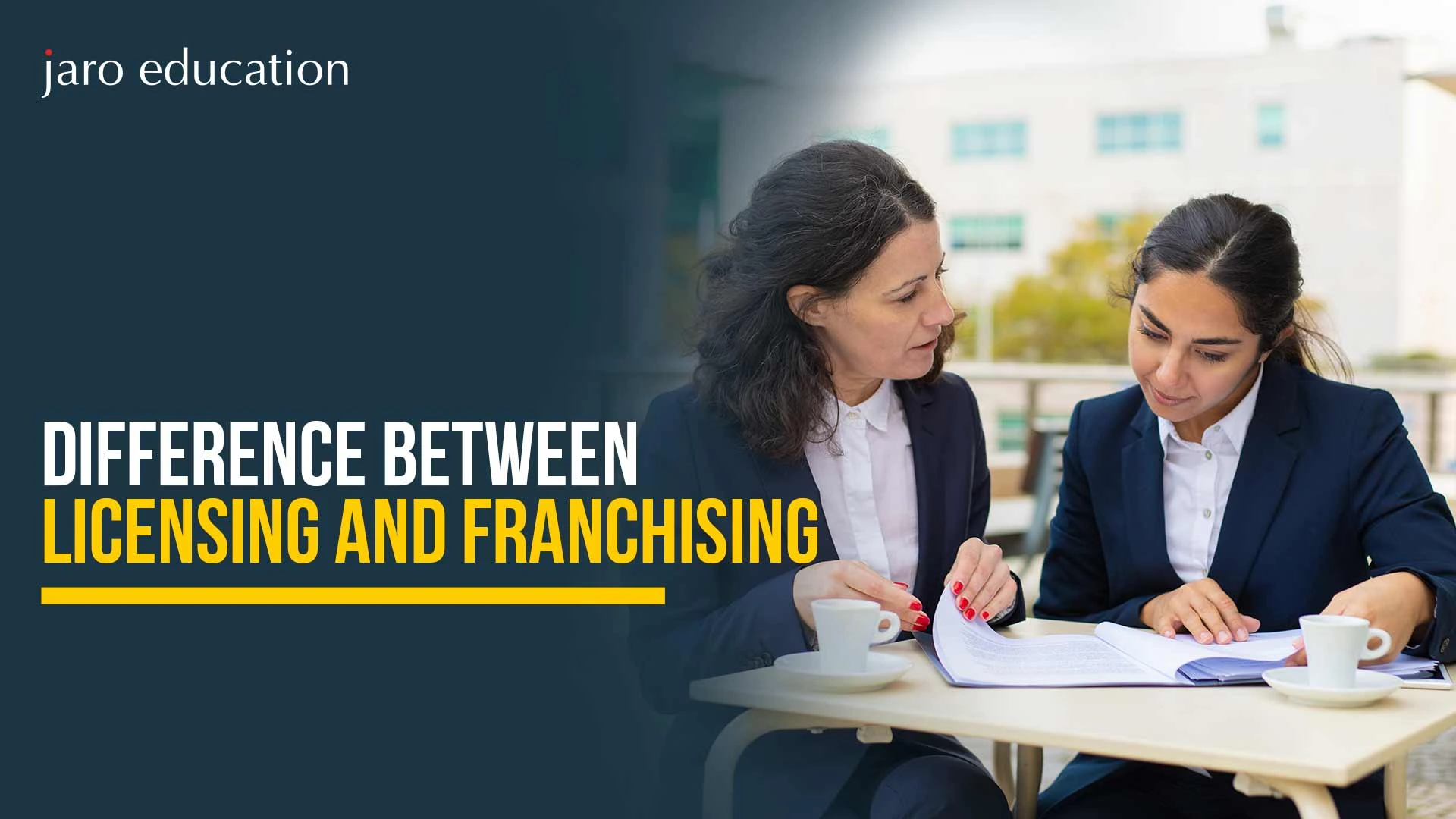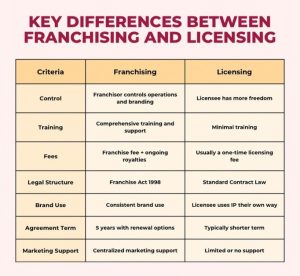
Difference Between Licensing and Franchising
Understanding the difference between licensing and franchising is crucial for entrepreneurs, business students, and corporate professionals. Both models allow businesses to expand without directly investing in new operations. However, they differ in terms of control, investment, branding, and operational involvement.
In this blog, we break down the difference between licensing and franchising with examples, charts, and actionable insights.
Table Of Content
Licensing vs Franchising: How They Differ in Business Structure
Licensing vs Franchising: Quick Comparison Table
Detailed Differences Between Licensing and Franchising
Licensing and Franchising Examples: Real-World Insights
Pros and Cons of Licensing and Franchising
When to Choose Licensing vs Franchising
Licensing and Franchising in Different Industries
Legal Considerations for Licensing and Franchising
Jaro Education: Upskill in Business Management
Conclusion
Frequently Asked Questions
Licensing vs Franchising: How They Differ in Business Structure

*issuu.com
This highlights a key aspect of the difference between licensing and franchising, while licensing focuses on IP usage, franchising covers the complete business model.
What is Licensing?
Licensing is a business arrangement where one company (the licensor) allows another company (the licensee) to use its intellectual property, brand, or technology in exchange for a fee or royalty.
Key points about licensing:
- Licensor retains ownership of the intellectual property.
- Licensee pays royalties or a licensing fee.
- Limited operational control from the licensor.
- Usually involves patents, trademarks, copyrights, or technology.
Examples of licensing:
- Disney allowing manufacturers to produce toys featuring Disney characters.
- Microsoft licensing Windows OS to computer manufacturers.
- Pharmaceutical companies licensing drug formulas to other manufacturers.
What is Franchising?
Franchising is a model where a franchisor grants the right to operate a business using its brand, system, and operational methods. The franchisee typically pays an initial fee and ongoing royalties.
Key points about franchising:
- Franchisor provides a complete business model.
- Franchisee follows strict operational guidelines.
- The brand and marketing support come from the franchisor.
- Often used in retail, food, and service industries.
Examples of franchising:
- McDonald’s and its global franchises.
- Subway restaurant chains.
- Anytime Fitness gyms.
Licensing vs Franchising: Quick Comparison Table
| Feature | Licensing | Franchising |
| Ownership | IP remains with licensor | Business operates under the franchisor’s brand |
| Control | Minimal operational control | High control over business operations |
| Investment Required | Lower upfront cost | Higher initial investment |
| Brand Use | Limited to a specific IP | Full brand and system usage |
| Support & Training | Usually minimal | Extensive support and training |
| Revenue Model | Royalties or licensing fees | Franchise fees + ongoing royalties |
| Example | Disney, Microsoft | McDonald’s, Subway |
Detailed Differences Between Licensing and Franchising

*mirajconsultancy
To understand the difference between licensing and franchising, consider how they vary in control, investment, brand involvement, legal agreements, and support.
1. Control Over Operations
Licensing:
The licensor has little to no control over how the licensee operates the business. They focus mainly on the use of IP.
Franchising:
The franchisor maintains strict control over daily operations, marketing strategies, and customer service standards.
2. Investment and Fees
Licensing:
Licensees usually pay a fixed royalty or fee. The financial risk is lower.
Franchising:
Franchisees pay an initial franchise fee and ongoing royalties. The investment is higher, but so is the potential for brand-driven revenue.
3. Brand Involvement
Licensing:
The licensee can leverage the brand, but the brand identity is not deeply integrated into operations.
Franchising:
The franchisee fully operates under the brand’s identity, following established guidelines and protocols.
4. Legal and Contractual Agreements
Licensing:
The agreement mainly covers IP rights and royalties.
Franchising:
Contracts are comprehensive, covering brand usage, operational standards, training, marketing, and revenue sharing.
5. Support and Training
Licensing:
Minimal support is provided; the licensee is mostly independent.
Franchising:
Extensive training, marketing support, and operational assistance are standard.
These insights clearly show how the difference between licensing and franchising impacts business strategy and decision-making.
Licensing and Franchising Examples: Real-World Insights
Licensing examples:
Disney Merchandising:
Toys, apparel, and games under Disney characters.
Microsoft Software Licensing:
Windows OS pre-installed on computers.
Pharmaceutical Licensing:
Drug formulas licensed to other manufacturers for production.
Franchising examples:
McDonald’s:
Standardized menu, interior, and operational procedures.
Subway:
Uniform branding and marketing strategies globally.
KFC:
Operations strictly follow franchisor guidelines to maintain quality.
Pros and Cons of Licensing and Franchising
| Model | Pros | Cons |
| Licensing |
|
|
| Franchising |
|
|
When to Choose Licensing vs Franchising
Licensing is ideal when:
- You want to expand a product or intellectual property without heavy involvement.
- The primary focus is on generating revenue through royalties.
- The business model does not require direct operational control.
Franchising is ideal when:
- You aim for full brand consistency across all locations.
- The business requires active operational support and guidance.
- Long-term, high-revenue growth is the primary goal.
Licensing and Franchising in Different Industries
Technology
- Licensing software like Microsoft Windows or Adobe products.
- Franchising tech service centers like Apple Authorized Service Providers.
Food & Beverage
- Licensing recipes or branding to local restaurants.
- Franchising restaurant chains like Domino’s and McDonald’s.
Retail
- Licensing branded products to retailers.
- Franchising stores like Nike or Adidas retail outlets.
Legal Considerations for Licensing and Franchising
Key legal elements to consider are:
- Intellectual Property Rights: Clearly specify which IP, trademarks, or technology can be used.
- Royalties & Fees: Define the payment structure, including initial fees and ongoing royalties.
- Operational Guidelines: Outline permissible actions and responsibilities, especially critical in franchising.
- Termination Clauses: Clearly state the conditions under which the agreement can be ended.
Proper legal guidance helps both parties navigate their responsibilities, maintain compliance, and protect business interests.
Jaro Education: Upskill in Business Management
Some of our featured programs are:
- Online MBA – Dr. D. Y. Patil Vidyapeeth
- Online MBA – Manipal University, Jaipur
- Online MBA Degree Programme – Symbiosis School for Online and Digital Learning (SSODL)
- Online Master of Business Administration – Chandigarh University
- Executive MBA – Dayananda Sagar University
These programs empower professionals to make informed decisions on licensing, franchising, and business expansion strategies. By integrating theory with real-world business cases, learners can apply knowledge immediately in their careers.
Explore Jaro Education’s MBA programs today to master business expansion strategies.
Conclusion
Understanding the difference between licensing and franchising is essential for business owners and professionals. Licensing allows companies to monetize intellectual property with minimal involvement, while franchising provides full control over brand and operations.
By choosing the right model, businesses can expand efficiently while maintaining quality and brand integrity. Programs like those offered by Jaro Education help professionals understand these models deeply, preparing them for strategic decision-making in global markets.
Frequently Asked Questions
The primary difference between licensing and franchising lies in control and support. Licensing allows use of intellectual property with minimal oversight, while franchising involves strict operational guidelines and brand consistency.
Yes, legal guidance ensures proper protection of intellectual property, operational rules, and revenue agreements. Understanding the licensing and franchising difference is essential before signing any contracts.

